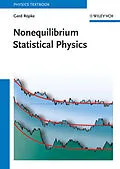Authored by a well-known expert in the field of nonequilibrium statistical physics, this book is a coherent presentation of the subject suitable for masters and PhD students, as well as postdocs in physics and related disciplines.
Starting from a general discussion of irreversibility and entropy, the method of nonequilibrium statistical operator is presented as a general concept. Stochastic processes are introduced as a necessary prerequisite to describe the evolution of a nonequilibrium state. Different standard approaches such as master equations, kinetic equations and linear response theory, are derived after special assumptions. This allows for an insight into the problems of nonequilibrium physics, a discussion of the limits of the approaches, and suggestions for improvements. The method of thermodynamic Green's function is outlined that allows for the systematic quantum statistical treatment of many-body systems. Applications and typical examples are given, as well as fully worked problems.
Autorentext
Gerd Röpke is professor of Theoretical Physics at the University of Rostock, Germany. Having obtained his academic degrees from the University of Leipzig, he spent most of his career working at the Technical University Dresden before the appointment at Rostock. Professor Röpke has authored over 400 scientific publications on quantum statistics, nonequilibrium statistical mechanics, plasma physics and nuclear theory, including several monographs, and he received different awards. He is a member of the Saxonian Academy of Sciences and external member of the Max-Planck Society.
Inhalt
Preface XI
1 Introduction 1
1.1 Irreversibility: The Arrow of Time 2
1.1.1 Dynamical Systems 3
1.1.2 Thermodynamics 7
1.1.3 Ensembles and Probability Distribution 9
1.1.4 Entropy in Equilibrium Systems 11
1.1.5 Fundamental Time Arrows, Units 14
1.1.6 Example: Ideal Quantum Gases 17
1.2 Thermodynamics of Irreversible Processes 19
1.2.1 Quasiequilibrium 19
1.2.2 Statistical Thermodynamics with Relevant Observables 22
1.2.3 Phenomenological Description of Irreversible Processes 25
1.2.4 Example: Reaction Rates 29
1.2.5 Principle of Weakening of Initial Correlations and the Method of Nonequilibrium Statistical Operator 31
Exercises 38
2 Stochastic Processes 41
2.1 Stochastic Processes with Discrete Event Times 42
2.1.1 Potentiality and Options, Chance and Probabilities 43
2.1.2 Stochastic Processes 46
2.1.3 Reduced Probabilities 50
2.1.4 Properties of Probability Distributions: Examples 54
2.1.5 Example: One-Step Process on a Discrete SpaceTime Lattice and Random Walk 58
2.2 Birth-and-Death Processes and Master Equation 61
2.2.1 Continuous Time Limit and Master Equation 63
2.2.2 Example: Radioactive Decay 67
2.2.3 Spectral Density and Autocorrelation Functions 69
2.2.4 Example: Continuum Limit of Random Walk and Wiener Process 76
2.2.5 Further Examples for Stochastic One-Step Processes 78
2.2.6 Advanced Example: Telegraph Equation and Poisson Process 84
2.3 Brownian Motion and Langevin Equation 89
2.3.1 Langevin Equation 89
2.3.2 Solution of the Langevin Equation by Fourier Transformation 94
2.3.3 Example Calculations for a Langevin Process on Discrete Time 95
2.3.4 FokkerPlanck Equation 96
2.3.5 Application to Brownian Motion 105
2.3.6 Important Continuous Markov Processes 107
2.3.7 Stochastic Differential Equations and White Noise 109
2.3.8 Applications of Continuous Stochastic Processes 110
Exercises 113
3 Quantum Master Equation 117
3.1 Derivation of the Quantum Master Equation 119
3.1.1 Open Systems Interacting with a Bath 119
3.1.2 Derivation of the Quantum Master Equation 124
3.1.3 BornMarkov and Rotating Wave Approximations 127
3.1.4 Example: Harmonic Oscillator in a Bath 132
3.1.5 Example: Atom Coupled to the Electromagnetic Field 135
3.2 Properties of the Quantum Master Equation and Examples 138
3.2.1 Pauli Equation 138
3.2.2 Properties of the Pauli Equation, Examples 143
3.2.3 Discussion of the Pauli Equation 146
3.2.4 Example: Linear Coupling to the Bath 148
3.2.5 Quantum FokkerPlanck Equation 151
3.2.6 Quantum Brownian Motion and the Classical Limit 154
Exercises 156
4 Kinetic Theory 157
4.1 The Boltzmann Equation 158
4.1.1 Distribution Function 159
4.1.2 Classical Reduced Distribution Functions 163
4.1.3 Quantum Statistical Reduced Distribution Functions 166
4.1.4 The Stoßzahlansatz 169
4.1.5 Derivation of the Boltzmann Equation from the Nonequilibrium Statistical Operator 173
4.1.6 Properties of the Boltzmann Equation 180
4.1.7 Example: Hard Spheres 181
4.1.8 Beyond the Boltzmann Kinetic Equation 183
4.2 Solutions of the Boltzmann Equation 186
4.2.1 The Linearized Boltzmann Equation 187
4.2.2 Relaxation Time Method 189
4.2.3 The Kohler Variational Principle 194
4.2.4 Example: Thermal Conductivity in Gases 196
4.3 The VlasovLandau Equation and Hydrodynamic Equations 199
4.3.1 Derivation of the Vlasov Equation 199
4.3.2 The Landau Collision Term 201
4.3.3 Example for the Vlasov Equation: The RPA Dielectric Function 203
4.3.4 Equations of Hydrodynamics 206
4.3.5 General Remarks to Kinetic Equations 213
